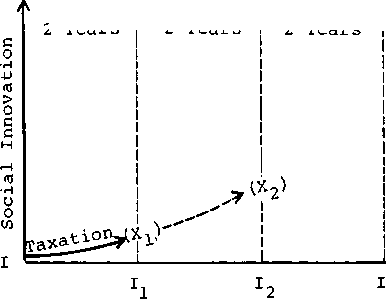of participation in governing themselves. The problem is becoming
acute at both extremes—the major cities and the rural counties.
The university can overcome its organizational insensitivity to
these matters. It can gradually enlarge the supply of knowledge to
help people improve the performance of systems like those above.
Below is outlined one strategy which is staged in this illustration over
a ten-year planning horizon. This strategy recognizes that present re-
sources cannot be shifted in significant measure from the technological
function on the horizontal axis (Figure 1) to the social innovation
function on the vertical axis, which is in a wholly new direction. With
presently limited resources only small incremental shifts can be turned
to the new function.
Stage 1. The deans, with the overall responsibility for research
and extension administration, can with the president establish as a
developmental objective the providing of scientific knowledge and
public education on one important system affecting human welfare.
They create the research base by making a modest but distinct re-
search commitment. In Figure 1, the taxing system is the case to be
illustrated. The initial research goal is represented as Xi and contains
the knowledge needs of state citizens confronted with making deci-
sions on taxation.
Almost every university research and extension service has for
brief periods organized special research task forces and extension
efforts to respond to critical local problems. The particular model for
the strategy illustrated in Stage 1 is Iowa’s special operation, “Financ-
s
2
Years
2 Years

2 Years
2 Years
Years
3 14
Technological Innovation
15
Figure 1. Flow of Resources to New Research and
Educational Functions, Stage 1
19
More intriguing information
1. Developmental changes in the theta response system: a single sweep analysis2. The name is absent
3. The name is absent
4. Economie de l’entrepreneur faits et théories (The economics of entrepreneur facts and theories)
5. Income Mobility of Owners of Small Businesses when Boundaries between Occupations are Vague
6. The Macroeconomic Determinants of Volatility in Precious Metals Markets
7. EU enlargement and environmental policy
8. Dual Track Reforms: With and Without Losers
9. Credit Market Competition and Capital Regulation
10. Competition In or For the Field: Which is Better